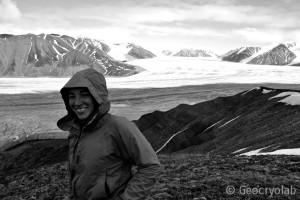 Stéphanie Coulombe
Stéphanie Coulombe
Director:
Daniel Fortier
Codirector:
Denis Lacelle (U.Ottawa)
Primary Address:
Department of Geography
Strathcona building, Room 404
Université de Montréal
520 chemin de la Côte-Sainte-Catherine
Montréal, Qc, Canada, H2V 2B8
Phone: (514) 343-6111 ext.33546
Email: [email protected]
Project Title
Paleoglaciology of Bylot Island at the Pliocene-Pleistocene transition
Description of the project research
The analysis of ground-ice characteristics can give numerous clues about the geomorphologic processes and the thermal conditions at the time when permafrost developed (Pollard, 1990). Massive underground ice therefore shows a great potential as a natural archive of the earth’s past climate. As a consequence of degrading permafrost, active-layer detachments from the underlying frozen ground expose extensive icy bodies preserved in the permafrost. My project focuses on these massive icy bodies exposed on a plateau located at the southwest end of Bylot Island, in the Canadian High Arctic. This ice was first interpreted as an old relict of glacier ice buried under glacio-fluvial sediments (Fortier, 2009). Through the investigation of the topographic position in the valley, the geomorphologic context, the depositional settings and ages of the overlying deposits, these bodies of massive ice are associated to different episodes of Pleistocene glaciations (early Pleistocene to late Pleistocene/early Holocene).
This project research focuses on reconstitutions of climatic and environmental conditions on Bylot Island based upon Pleistocene–aged permafrost ground-ice. Our results will help to quantify the major and abrupt climatic shift that occurred on Bylot Island at the Plio-Pleistocene boundary and the following Pleistocene glacial cycles. The long-term preservation of massive ground-ice and permafrost through the late Quaternary interglacials may suggests the occurrence of negative feedbacks mechanisms that made permafrost resilient to climate changes. Furthermore, little is known about massive underground ice of glacial origin so this study will help to characterize cryofacies and to determine the conditions of burial of glacier ice, and then. Massive ground ice characterization will be required for future northern infrastructure (e.g. Mary River Iron Mine). Indeed, improving knowledge of current permafrost conditions is now critical for northern infrastructure and community developments.
Keywords: Permafrost, Massive ice, Bylot Island, Crystallography, Isotopes, Paleomagnetism
Scientific articles in peer-review journals & conferences
Coulombe, S., Fortier, D. et Stephani, E. (2012), Using air convection ducts to control permafrost degradation under road infrastructures: Beaver Creek experimental site (Yukon), Proceedings of the 15th International Specialty Conference on Cold Regions Engineering, Québec, Canada, 11 p.
Conference presentations
Coulombe, S., Fortier, D., Stephani, E. (2013) Using Air Convection Ducts to Control Permafrost Degradation Under Road Infrastructure. Transport Canada Workshop, February 13th, Ottawa, Canada.
Coulombe, S., Fortier, D. (2012) Using Air Convection Ducts to Control Permafrost Degradation Under Road Infrastructure, Beaver Creek Experimental Site, Yukon, Canada. Third Annual Workshop of the Canadian Network of Expertise on Permafrost, May 26-30, Pangnirtung, Nunavut, Canada.
Conference posters
Coulombe, S., Fortier D., (2012), Characterization of massive ground-ice at Bylot Island, Nunavut. Poster presented at the 8 th Annual Scientific Meeting of ArcticNet, December 10-1410, Vancouver, Canada
Coulombe, S., Fortier, D (2012), Paleoglaciology of Bylot Island at the Pliocene-Pleistocene transition, Affiche présentée à la 10e conférence des étudiants en études nordiques de l’AUCEN, 1er au 3 novembre 2012, Val-d’Or, Université du Québec en Abitibi-Témiscamingue, Canada
Coulombe, S., Fortier D., (2012), La glace de glacier enfouie dans le pergélisol, une fenêtre sur le passé: exemple de l’île Bylot, Arctique canadien . Affiche présentée au Symposium nordique, February 9-10, Université du Québec à Rimouski, Canada
Fortier, D., Coulombe, S. (2012) Using air convection ducts to control permafrost degradation under road infrastructure: Beaver Creek experimental site, Yukon, Canada. Symposium international Canada-Chine sur les technologies d’opération de routes en milieu froid, 4-11 Mars, Changchung, Chine
Coulombe, S., Fortier, D. (2012) Engineering Techniques to Control Permafrost Degradation Under Road Infrastructure: Longitudinal Air Convection Ducts. Northern Forum workshop, April 19-20, Québec, Canada
Fortier, D., Coulombe, S., Kanevskiy, M., Paquette, M., Shur, Y. et Stephani, E. (2011), Buried glacier ice in permafrost, a window to the past: examples from Bylot Island, Canadian Arctic. EOS Transactions of the American Geophysical Union, Fall Meeting Supplement, Abstract C41C-0418.
Coulombe, S., Fortier D., Stephani, E. (2011). Engineering techniques to control permafrost degradation under road infrastructures: Longitudinal air convection ducts. Poster presented at the 41st annual Arctic Workshop meeting, March 2-4, Montreal, Québec, Canada
Coulombe. S., Fortier D., Stephani, E. (2011). Techniques d’ingénierie visant à contrôler la dégradation du pergélisol sous les infrastructures routières au Yukon: la technique des conduits à convection . Poster presented at the Symposium nordique, February 9-10, Université Laval, Québec, Canada
Scientific reports
Fortier, D., Lévesque, E., Coulombe, S., Godin, E., Gérin-Lajoie, J. (2012) Dynamics of periglacial ecosystems in a changing climate, Bylot island, Nunavut, Canada, Field report, Parks Canada, 8 pp.
Fortier, D., Lévesque, E., Coulombe, S. et Godin, E. (2011), Dynamique des écosystèmes périglaciaire de l’Île Bylot en réponse aux changements climatiques, Nunavut, Canada. Field report, Parks Canada,, 13 p.
Fortier, D., Davesne, G., Hotte, M., Coulombe, S., Pelletier, F., Larrivée, K., Paquette, M., Gray, J. (2011) Étude du couvert de neige au sommet du Mont Jacques-Cartier (Massif des Chic-Chocs, Gaspé, Québec). Field report, Laboratoire de géomorphologie et de géotechnique des régions froides (Geocryolab), Université de Montréal, Montréal, Canada : 29 pp.
Scholarships and other awards
2013: Ph.D scholarship, Fonds de recherche du Québec sur la nature et les technologies (FQRNT)
2013: Northern Scientific Training Program (NSTP), Aboriginal Affairs ans Northern Development Canada
2012: The W. Garfield Weston Award for Northern Studies, Association of Canadian Universities for Northern Studies (AUCEN)
2012: Alexander-Graham-Bell Canada Graduate Scholarship, Natural Science and Engineering Research Council of Canada (NSERC)
2012: Northern Scientific Training Program (NSTP), Aboriginal Affairs and Northern Development Canada
2011: Masters research scholarship, Fonds de recherche du Québec sur la nature et les technologies (FQRNT)
2011: Undergraduate Student Research Award (USRA), Natural Science and Engineering Research Council of Canada (NSERC)
2011: Northern Scientific Training Program (NSTP), Aboriginal Affairs and Northern Development Canada
2011: Best presentation award in physical geography, University of Montreal
2011: Dean’s award for excellence, University of Montreal
2010: Excellence scholarship, University of Montreal
2010: Dean’s award for excellence, University of Montreal
2009: Excellence scholarship, University of Montreal
2009: Dean’s award for excellence, University of Montreal
2009: Rhoda Weiss-Lambrou award, University of Montreal
Affiliations
Center for Northern Studies, Laval University, Quebec
ArcticNet
Arctic Development and Adaptation to Permafrost in Transition (ADAPT)
Permafrost Young Researchers Network (PYRN)
Association of Polar Early Carrer Scientists (APECS)
International Permafrost Association (IPA)
Ce message est également disponible en : French

Stéphanie Coulombe
by
Geocryolab
is licensed under a
Creative Commons Attribution-NonCommercial 4.0 International License
.
